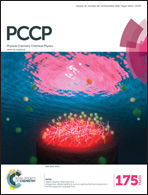Synthesis and reductive elimination of arylPd(ii) trifluoromethyl complexes: a remarkable concentration effect on chemoselectivity†
Abstract
Reductive elimination from Pd(II) aryl trifluoromethyl complexes is a challenging and elusive step which is accompanied by a number of kinetically more favorable side reactions giving rising to a complex mixture. We report herein the synthesis and isolation of several arylPd(II) trifluoromethyl complexes (2a–c) and study their electronic structures, photophysical properties and reductive elimination reactivities. A remarkable concentration effect on chemoselectivity is observed for thermal decomposition of (Xantphos)Pd(II)(Ar)(CF3) (2c) that favors the formation of Ar–CF3 at lower concentrations, but gives increasingly more Ar–Ar homocoupling product to a dominant extent as the concentration of 2c increases. This is solid evidence for the involvement of an intermolecular Ar/CF3 ligand exchange/Ar–Ar reductive elimination mechanism that has been proposed based on DFT computational studies. The interplay between theory and experiment provides valuable insights into the mechanism and kinetics of the key elementary reaction of reductive elimination at Pd(II), and may thus prompt the design of more efficient Pd-mediated nucleophilic trifluoromethylation reactions.


 Please wait while we load your content...
Please wait while we load your content...